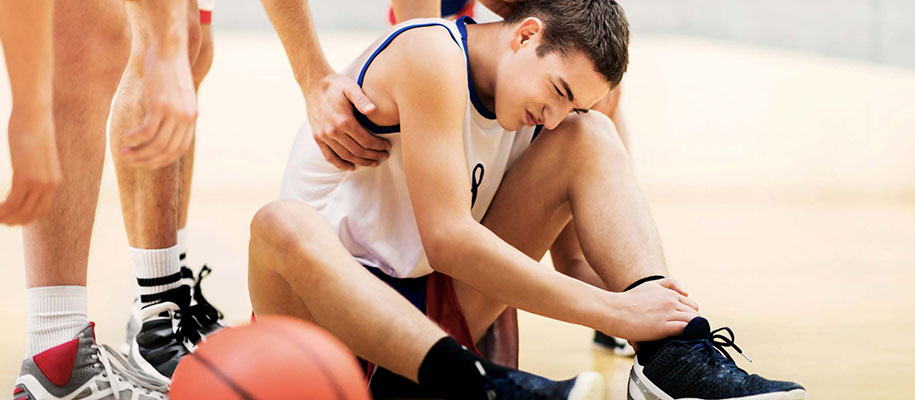Unfortunately, injuries happen often in college athletics and are often unavoidable, depending on the sport. And though many of these injuries are minor, student-athletes still need to be careful and take care of themselves so a minor injury doesn’t turn into a major problem. As a former Division I student-athlete, I watched close friends and peers succumb to an injury. Some were minor, some required time off, and some were career ending. I battled through some injuries myself and have some key takeaways on how to go about the intimidating process of rehabilitation.
First: Don’t panic!
When you first get hurt and thoughts are flying a million miles an hour through your head, try to stay calm! Your body doesn’t need any added stress. Instead, pinpoint exactly where the pain is stemming from and try to relax. Maybe your muscles are tight and just need a good stretch. Maybe you fell in a game and need some ice. Regardless of what caused the pain, the high level of commitment you give as a student-athlete can be a lot for your body to handle. Add in coursework, your personal life, and work and it can be overwhelming. As long as you take care of yourself and stay composed, you can figure out the next steps on how to heal.
Related: What You Need to Know About Health Insurance for Student-Athletes
Don’t ignore pain or discomfort
Pain is a way for our bodies to inform us that something isn’t right. Ignoring this will only lead to more issues down the road, which could result in time spent off the field or court. Before you jump to conclusions, give the pained spot some extra attention. Notice how it feels when you move: Does it worsen? Does it bother you when you’re sitting or at rest? If the pain persists over a few days or it’s at an unbearable level, consult your athletic trainer. Listen to your gut on these aches and pains, and if something is bothering you, speak up about it! At the end of the day, we only have ourselves and our bodies, so we should always be proactive in taking care of them.
Open communication is key
Your athletic trainer is there for you at all times. It’s their job to make sure you and your teammates are healthy and in tip-top shape for competition. They have a plethora of knowledge when it comes to sports medicine. Set up a time to chat with your trainer, and they’ll give you small exercises to treat your ache or pain. While you take the time to treat the area that hasn’t been feeling right, your trainer will keep an eye on you to ensure you’re doing everything you can. They’ll also be the ones to keep in contact with your coaching staff about the status of your injury, so don’t sweat it! If your pain or ache persists, make sure to let your trainer know so they can adjust your rehab plan accordingly.
Healing an injury takes time
What do you mean my injury isn’t healed after a good night’s sleep? As a sometimes stubborn and impatient person, I had a hard time wrapping my head around this one. But it’s important to not get discouraged if it takes your injuries a while to heal. You thought you’d be better in two weeks, and maybe it’s taking three. Don’t rush the healing process or you might start taking steps backward. It’s better to be cautious and take your time than to rush back into playing. Take the extra time to foam roll, stretch, and ice—these steps will only benefit you. It’s easy to become frustrated, but small steps forward are still progress.
Related: What Student-Athletes Should Do About Major Injuries
Personal experience
Apart from some bumps, bruises, scrapes, and countless turf burns, I was fortunate enough to have an overall healthy athletic career. I knew that playing at the Division I level was the highest caliber of competition I would ever be a part of, which led me to push myself past my limits. This led to a sharp pain that began to spread over the top of my foot. I dismissed this pain as nothing and brushed it off, assuming I got hit with the field hockey ball. Over the course of a few weeks, it intensified to a point where I began walking on the outside of my foot just to avoid the spider-webbing pain with every step. Things began to unravel, and I finally told myself to consult my athletic trainer. After assessing a few things and taking a week to see if a few exercises would suffice, she set me up for an X-ray.
It turned out to be a stress fracture, a common injury defined as an overuse injury. I was placed in a boot and was told to follow up after four weeks. Luckily, this was in my off-season, but this meant four weeks of modified weight lifting and no practicing. I felt a little defeated but ultimately knew I had to listen to my body and slow down. I turned my frustration into ambition and was determined to focus on healing myself so I could return to the field better than ever.
Lessons learned
Reflecting on my own experience, the stress fracture was just a bump in the road. If I had spoken up about the pain sooner, would I have avoided the four weeks of wearing the boot? Potentially. If I waited any longer, could I have made the fracture worse? Absolutely. As an underclassman at the time of the injury, I was afraid it would impact my minutes on the field. I was intimidated to speak up and wanted to play through the pain. Our bodies do so much for us day after day, they deserve to be taken care of and monitored. I’m thankful to have had a great support system to help me bounce back and for my athletic trainer for setting me up for success.
Related: Good Health and Nutrition Tips for College Student-Athletes
Injuries don’t define us as athletes, but how we respond to them does. You may injure yourself and initially think you’ll be back on the field in a couple of days, but pushing yourself too soon can result in long-term effects. Take a step back and look how far you’ve come—and how far you can go. You certainly won’t be able to get there if you don’t take your injuries seriously. And just remember: the comeback is always greater than the setback—so take your time to make that comeback worth it.
Learn more about playing sports in college and life as a student-athlete in our College Athletics section.







